What Project Screen App Works For My Lg K10 Cell Phone
LG K10 (2017) Smartphone Review
Power to the people. The LG K10 (2017) brings considerably more power than its predecessor and provides an even better quality casing. A polished performance for slightly over 200 Euros (~$217), but of course we will take a more careful look at the smartphone in the test.
Update: New build brings general improvements and security updates.
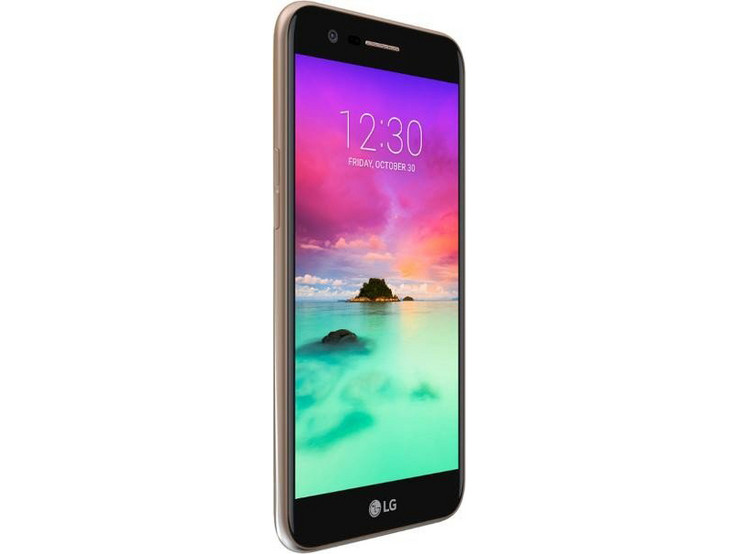
For the original German review, see here.
The LG K10 gets a successor, just as LG reissues its complete K-series as affordable entry-level smartphones. The LG K10 (2017) is again the most expensive and best-equipped device of the series. For a price of a little over 200 Euros (~$217), it brings LTE, a wide-angle selfie camera, and a fast processor. At the time of testing, the smartphone can be purchased on the Internet far below its suggested retail price. Therefore we use smartphones that you can currently get for between 150 and 220 Euros (~$162-238) for our comparison: the Samsung Galaxy J3 for example, the HTC One A9s, the Asus ZenFone 3 Max with a large battery, and the Lenovo Moto G4 Play.
Update 08-22-2017: The new build NRD90U brings general improvements and increases the security. Please refer to the Software section for detailed information.
Update 12/03/2017: a new firmware brings general improvements and improves security. Details can be found in the Software section.
Display
5.30 inch 16:9, 1280 x 720 pixel 277 PPI, capacitive touchscreen, IPS, glossy: yes
Storage
16 GB eMMC Flash, 16 GB
, 11 GB free
Weight
138 g ( = 4.87 oz / 0.3 pounds), Power Supply: 49 g ( = 1.73 oz / 0.11 pounds)
Note: The manufacturer may use components from different suppliers including display panels, drives or memory sticks with similar specifications.
In terms of its casing, the LG K10 (2017) became slightly higher quality. There is still just a plastic casing in modest black or a little more daring rose-gold. Only the earpiece grill, the ring around the camera, the bottom edge of the smartphone, and a small band around the casing are colored. However, especially because of this sparing use, the rose-gold coloring looks very premium. The 2.5D glass on the front has remained, so the edges also seem to continue to curve around the corners, where a gap to the frame weakens this effect. Just as in its predecessor, the rounded form results in a very ergonomic smartphone that lies comfortably in the hand.
At 138 grams (~4.8 oz), the LG K10 (2017) became 2 grams lighter compared to the predecessor. The smartphone is also lighter than the other smartphones in the comparison. The silhouette was also slimmed considerably at 7.99 millimeters (~0.32 in), but there is still a removable battery and removable back. Talking about the back: it is now smooth, but there is a discreet stripe pattern that looks very sophisticated. Aside from a standby button, the controls on the back have also now been removed.
The stability is okay, but pressure on the back and front quickly becomes visible in the liquid crystal of the screen. Moreover, the smartphone can be twisted a little. However, an overall impression of a rather high quality remains, especially considering the price.
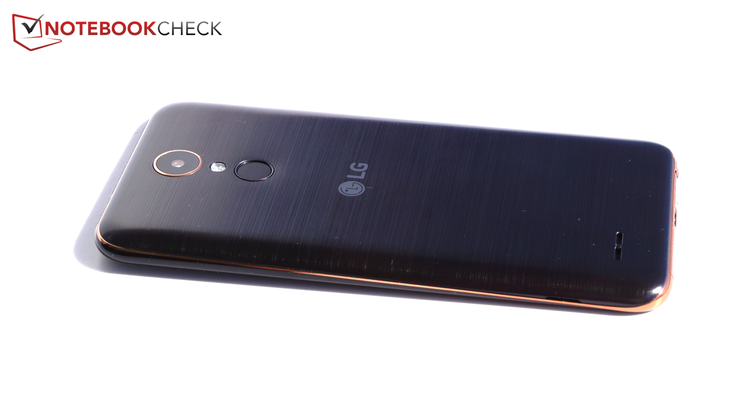
❌
Like its predecessor, the LG K10 (2017) is also not a dual-SIM smartphone. 16 GB memory storage and 2 GB RAM are no surprises in this class, but the HTC One A9s or the Asus ZenFone 3 Max prove that in the meantime more storage can also be had at this price. The storage can be extended via microSD card, which can also be used as internal storage. However, when using it as removable storage, apps cannot be moved onto the storage card.
Bluetooth 4.2 is supported, a standard that is quite current and furthermore the LG K10 (2017) can communicate via NFC like its predecessor before.
LG installs Google's current Android 7 operating system on the smartphone and overlays it with its own user interface. At the time of testing, the current software version was installed, and the security patches were from February 1, 2017 and therefore fairly current. Other than the quite useful Evernote app, there are no third-party apps on the smartphone in the delivery condition, so no bloatware or advertising either. However, LG installs its own app store called "LG SmartWorld," which can be used alternatively to the Google Play Store but offers the same content. Data can be transferred to another device, or a local backup can be created via LG Backup.
LG's own launcher changes the structure of the settings by ordering them into categories. There is no separate app drawer that provides an overview of all apps, but the apps end up on several home screens that are placed next to each other. The notification center looks different as well and is also controlled differently. LG's own apps for telephone, SMS, and email are installed. However, overall the LG K10 (2017) can be operated without problems by anybody who has held a smartphone in their hands before.
Update 08-22-2017: LG distributes the OTA update to build version NRD90U (version: V10g-APR-20-2017, 521 MB). It is supposed to improve "user friendliness and functionality of the phone". The manufacturer does not describe details however. Google's security patches as of 04-01-2017 are implemented.
Update 12/03/2017: LG has released firmware V10I-SEP-27-2017 (203 MB) with general improvements and Google's security patches as of 09/01/2017.
Anyone who pays 200 Euros (~$217) for a smartphone can assume that their device includes LTE capabilities at this point. The LG K10 (2017) does not disappoint here, either. Like its predecessor, it offers four GSM, four UMTS, and five LTE frequency bands. The maximum download speed has increased: data can now be downloaded via LTE at up to 300 MBits per second. In inner-city areas, the reception is good inside as well: we had mostly a 4/5 signal strength at least in the well-established German Vodafone net.
In terms of WLAN, you have to be content with 802.11 b/g/n, as the less congested 5-GHz band will not be accessible. The transfer rates are in the expected ranges, so they are okay. However, the HTC One A9s shows that considerably faster speeds are possible. The reception is strong near the router, but the page rendering is fairly slow. At a 10-meter (~33 ft) distance and through three walls, the reception remains good at 4/5 of the signal strength, but the pages render quite slowly here as well.
| Networking | |
| iperf3 Client (transmit) TCP 1 m 4M x10 | |
| HTC One A9s Mali-T860 MP2, Helio P10 MT6755, 32 GB eMMC Flash | 109 MBit/s ∼100% +100% |
| LG K10 2017 Mali-T860 MP2, MT6750, 16 GB eMMC Flash | 54.6 MBit/s ∼50% |
| Asus Zenfone 3 Max ZC520TL Mali-T720 MP2, MT6737, 32 GB eMMC Flash | 49.7 MBit/s ∼46% -9% |
| iperf3 Client (receive) TCP 1 m 4M x10 | |
| HTC One A9s Mali-T860 MP2, Helio P10 MT6755, 32 GB eMMC Flash | 102 MBit/s ∼100% +121% |
| Asus Zenfone 3 Max ZC520TL Mali-T720 MP2, MT6737, 32 GB eMMC Flash | 47.4 MBit/s ∼46% +3% |
| LG K10 2017 Mali-T860 MP2, MT6750, 16 GB eMMC Flash | 46.2 MBit/s ∼45% |
When activating the GPS module of the LG K10 (2017), our location is not found when inside. Outside, the signal is sufficiently strong to locate us down to six meters (~20 ft) - an average result.
We took the LG K10 (2017) on a bike tour to check the precision of the GPS. Also in our gear: the Garmin Edge 500 professional navigator, which serves as our reference device. On the 12-kilometer route (~7.5 miles), the measured distances differ by 400 meters (0.25 miles), which is a slightly higher deviation than usual. Yet, the LG K10 (2017) does not perform badly: though some corners are cut, and the device does not always place us on the exact path, all in all, the location is more exact than with some other comparison devices. The predecessor could score here before as well.
The telephone app was reworked by LG, but overall offers a similar structure to Google's standard app, with tabs at the top for each function and a large key area. Something special: Optionally, a mini-version of the app can be placed floating on the start screen, the function is called "QSlide."
On our side, the call quality is decent, that is to say, through the earpiece our conversation partner can be heard clearly, intelligibly, and without greater disturbances. However, the microphone of the LG K10 (2017) produces considerable distortions in the voice, so that our partner has to live with a rather moderate voice quality. At least we are able to speak with a quiet or loud voice and the microphone still transfers the voice always intelligibly. In hands-free mode, the call quality decreases considerably on our side: our partner's voice sounds thin and tinny. The microphone has trouble when we speak with a low voice, and our voice still sounds unnatural to our conversation partners. Overall, calling on the LG K10 (2017) is passable, but the microphone has a rather poor quality.

On the back of the LG K10 (2017) is a 13-megapixel camera without any spectacular technical highlights. It does not need them: under normal light conditions, the camera takes good pictures with accurate colors and decent sharpness even in enlargements. Details such as distant trees seem very muddy in enlargements; here higher quality camera modules such as in the Huawei P10 have the edge. Otherwise, we can recommend the camera for photographs, as long as the light conditions are right: In dark situations the camera brightens too little, a strong noise becomes apparent, and the autofocus does not work right anymore as well.
LG's camera software offers many adjustments and filters (which are treated as different film material); you can activate an HDR mode and take pictures per voice command.
Videos can be recorded with the main camera in Full HD. The exposure adjusts quickly and without apparent steps to the new situation. However, we often had to readjust the focus, and the image appears quite dark. In addition, colors could be a little more vibrant.
The 5-megapixel front camera offers a 120-degree wide-angle lens. In dark areas, color reproduction, sharpness, and dynamic are quite decent. The camera can take good selfies, where you can choose between a wide-angle and narrower perspective. Optionally, if you hold the smartphone still, look into the camera and smile, the LG K10 (2017) can take a selfie automatically or triggered by gesture.
Image Comparison
Choose a scene and navigate within the first image. One click changes the position on touchscreens. One click on the zoomed-in image opens the original in a new window. The first image shows the scaled photograph of the test device.
Scene 1Scene 2Scene 3

click to load images
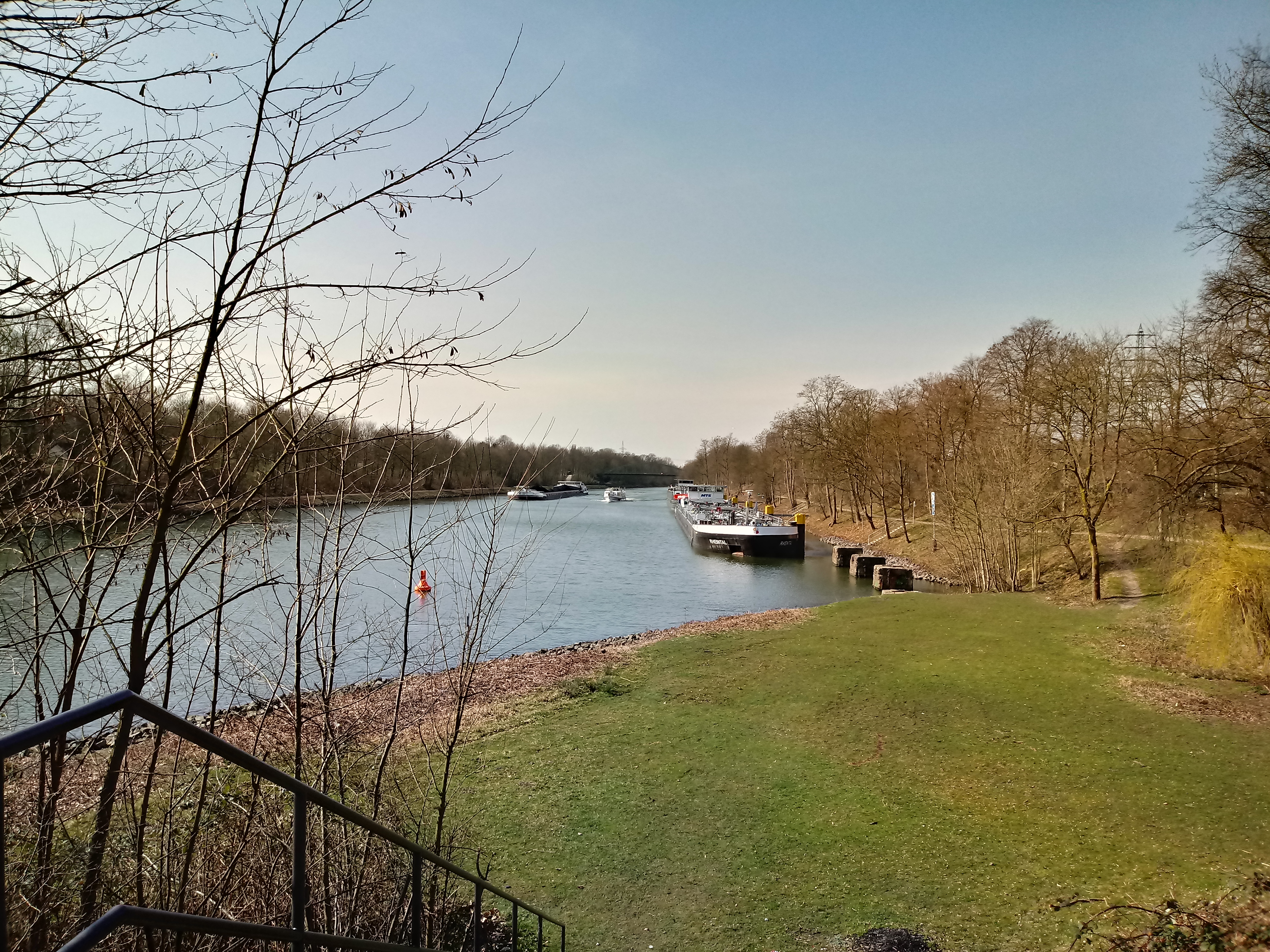
click to load images

click to load images
Under laboratory conditions with controlled exposure, the back camera also shows good sharpness of the details. Text in front of a colored background is always sharp; the edges do not appear quite clean, however. While the sharpness decreases slightly on the edges of the image, it is still good. However, the colors appear a little dull, the photo of the ColorChecker card shows a slightly spotty representation in many tones, and many color tones are clearly brighter than in the reference image.
With the included power supply, charging cable, and earphones, the LG K10 (2017) offers a conventional accessory package. LG's website does not offer any specific accessories.
The manufacturer offers a 24-month warranty on the smartphone and six months on the battery.Please see our Guarantees, Return policies and Warranties FAQ for country-specific information.
Although the standby button on the back suggests a fingerprint sensor, it is just an ordinary button. The LG K10 can only be unlocked with ordinary methods such as PIN or password, and by a KnockCode, a sequence of knocks where the pattern is simply tapped on the screen. This can also encrypt the smartphone.
The touchscreen is very precise, including into the corners. The menu keys are displayed on the screen and can be hidden when necessary. As is the convention, the volume rocker is on the case side, however here it is on the left side instead of the right as on most smartphones.
The keyboard was developed by LG in-house, but other keyboard apps can be downloaded and installed anytime. There is a separate number row, and the language can be switched quickly. The keys are doubly occupied, which makes them a little more cluttered. The keyboard height can be adjusted variably up to some limits. Swipe input is possible as well. Pressing the volume buttons twice with switched-off display will trigger specific functions: Volume Up starts a note function and Volume Down, the camera.
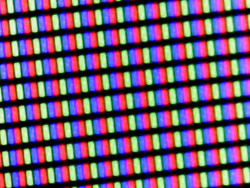
At 1280x720 pixels, the resolution of the IPS display exactly matches the standard for this class. The brightness is in mid-field at 350 cd/m²; the Asus ZenFone 3 Max, for example, glows considerably brighter. The brightness distribution is slightly uneven at 85%, which visibly illuminates large color areas unevenly.
| 332 cd/m² | 366 cd/m² | 338 cd/m² | ||
| 338 cd/m² | 384 cd/m² | 348 cd/m² | ||
| 328 cd/m² | 362 cd/m² | 351 cd/m² | ||
Distribution of brightness
X-Rite i1Pro 2
Maximum: 384 cd/m² (Nits) Average: 349.7 cd/m² Minimum: 3.07 cd/m²
Brightness Distribution: 85 %
Center on Battery: 384 cd/m²
Contrast: 1067:1 (Black: 0.36 cd/m²)
ΔE Color 6 | 0.59-29.43 Ø5.5
ΔE Greyscale 5.9 | 0.64-98 Ø5.7
Gamma: 2
| LG K10 2017 IPS, 1280x720, 5.30 | Samsung Galaxy J3 2016 Super AMOLED, 1280x720, 5.00 | Lenovo Moto G4 Play IPS, 1280x720, 5.00 | HTC One A9s IPS, 1280x720, 5.00 | Asus Zenfone 3 Max ZC520TL IPS, 1280x720, 5.20 | LG K10 IPS, 1280x720, 5.30 | |
|---|---|---|---|---|---|---|
| Screen | 6% | 4% | 24% | 13% | -3% | |
| Brightness middle | 384 | 295 -23% | 412 7% | 348 -9% | 507 32% | 370 -4% |
| Brightness | 350 | 299 -15% | 414 18% | 320 -9% | 474 35% | 355 1% |
| Brightness Distribution | 85 | 96 13% | 94 11% | 85 0% | 85 0% | 92 8% |
| Black Level * | 0.36 | 0.42 -17% | 0.23 36% | 0.53 -47% | 0.28 22% | |
| Contrast | 1067 | 981 -8% | 1513 42% | 957 -10% | 1321 24% | |
| Colorchecker dE 2000 * | 6 | 5.8 3% | 5.6 7% | 3.5 42% | 4.7 22% | 6.7 -12% |
| Colorchecker dE 2000 max. * | 14 | 8.6 39% | 9.7 31% | 6.4 54% | 7.2 49% | 17.8 -27% |
| Greyscale dE 2000 * | 5.9 | 4.8 19% | 6.9 -17% | 4 32% | 4.8 19% | 7.9 -34% |
| Gamma | 2 110% | 1.84 120% | 2.4 92% | 2.3 96% | 2.25 98% | 2.21 100% |
| CCT | 8042 81% | 6252 104% | 8422 77% | 6527 100% | 6441 101% | 9072 72% |
* ... smaller is better
Screen Flickering / PWM (Pulse-Width Modulation)
ℹ
To dim the screen, some notebooks will simply cycle the backlight on and off in rapid succession - a method called Pulse Width Modulation (PWM) . This cycling frequency should ideally be undetectable to the human eye. If said frequency is too low, users with sensitive eyes may experience strain or headaches or even notice the flickering altogether.
| Screen flickering / PWM not detected | 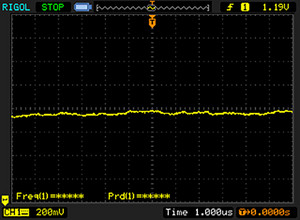 | ||
| In comparison: 52 % of all tested devices do not use PWM to dim the display. If PWM was detected, an average of 21006 (minimum: 5 - maximum: 3846000) Hz was measured. | |||
The black value of 0.36 cd/m² is good, but the HTC One A9s can do even better, and so can the Galaxy J3 that can render absolute black with its AMOLED display. At 1067:1 the contrast is also good; however, the HTC One A9s once again has a clear advantage. The colors on the display give the impression of a good balance between vibrant and natural.
The detailed analysis with the spectral photometer and the CalMAN software shows a pronounced blue tint. However, the LG K10 (2017) offers a so-called "Comfort mode" for the screen, which removes the blue spectrum from the image. But then the display appears with a strong yellow tint. The deviations of the color values in comparison to the reference sRGB color space are also of average height, but with blue colors, the deviations are especially strong. The color coverage of 71.4% is not particularly high; colors that cannot be displayed must be replaced with similar color tones. Note though, that the CalMAN measurements of the color-space coverage are not particularly exact but show more of a tendency, which in this case is obvious, however. Thus you should not rely on this display too much when judging colors, for example in photographs.
Display Response Times
ℹ
Display response times show how fast the screen is able to change from one color to the next. Slow response times can lead to afterimages and can cause moving objects to appear blurry (ghosting). Gamers of fast-paced 3D titles should pay special attention to fast response times.
| ↔ Response Time Black to White | ||
|---|---|---|
| 31.6 ms ... rise ↗ and fall ↘ combined | ↗ 17.6 ms rise | 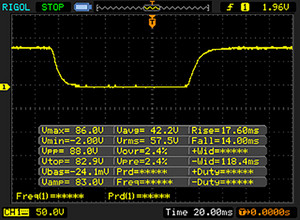 |
| ↘ 14 ms fall | ||
| The screen shows slow response rates in our tests and will be unsatisfactory for gamers. In comparison, all tested devices range from 0.8 (minimum) to 240 (maximum) ms. » 80 % of all devices are better. This means that the measured response time is worse than the average of all tested devices (23.8 ms). | ||
| ↔ Response Time 50% Grey to 80% Grey | ||
| 50 ms ... rise ↗ and fall ↘ combined | ↗ 25 ms rise | 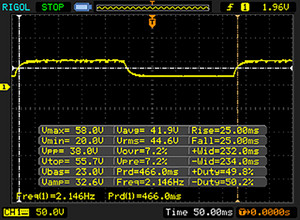 |
| ↘ 25 ms fall | ||
| The screen shows slow response rates in our tests and will be unsatisfactory for gamers. In comparison, all tested devices range from 0.8 (minimum) to 636 (maximum) ms. » 81 % of all devices are better. This means that the measured response time is worse than the average of all tested devices (37.5 ms). | ||
Outside, the display is very reflective and the mediocre display brightness often makes it difficult to recognize anything on the screen. The brightness sensor works quite reliably and selects a high brightness outside.
The viewing angles are very good, the screen content can be seen from wide angles, but slight shifts in brightness are visible.
In the section on performance, the LG K10 (2017) should be able to shine, since the MediaTek MT6750 SoC with eight cores and a maximum performance of 1.5 GHz is very current and powerful. Indeed the smartphone offers considerably more processing power than its predecessor. Most of the comparison devices compute considerably slower, only the HTC One A9s is faster. The difference to the slower comparison devices lies between 22% and 37%.
The graphics card of the LG K10 (2017) is the ARM Mali T860 MP2, which also clearly offers more power than the graphics solutions in the predecessor and most comparison devices. Again, only the HTC One A9s pulls ahead with even more power.
With the LG K10 (2017) you can surf the Internet faster than with most comparison devices. However, from time to time it still takes quite long to render websites. But demanding HTML5 pages mostly run quite fluidly.
Access to the external microSD card was already quite fast with the LG K10, and this year's model again clearly tops that: with our Toshiba Exceria Pro M401 reference card, the LG K10 (2017) offers the fastest access speeds of all comparison devices and closely approaches the maximum possible transfer speeds overall.
Reading the internal storage is also very fast on the LG K10 (2017). Writing happens slightly slower but still achieves decent values.
Most games run fluidly, even if they are more demanding. A fluid 30 frames per second cannot quite be reached inAsphalt 8 (in maximum details). Simpler games such asAngry Birds 2 run without stuttering and do not present any problems. Since the control via touchscreen and position sensor works very well, gaming on the LG K10 (2017) is quite fun.
| Asphalt 8: Airborne | |||
| Settings | Value | ||
| high | 29 fps | ||
| very low | 30 fps | ||
| Dead Trigger 2 | |||
| Settings | Value | ||
| high | 51 fps | ||

Under load, the casing temperature of the LG K10 (2017) reaches a maximum of 41.3 °C (106 °F). The area of the back camera especially heats up while the rest of the back remains noticeably cooler. In the front, it is mostly the center area that warms up. During idle operation, the temperatures are considerably lower, in parts by more than 10 °C. There is thus a noticeable warming, but it does not become uncomfortable or critical.
During the stress test with the battery benchmark of GFXBench, we cannot discern any throttling of the CPU and GPU, so apparently even during longer load the full power remains available.
| |||||||||||||||||||||||||
| Maximum: 40.1 °C = 104 F Average: 37.6 °C = 100 F | |||||||||||||||||||||||||
| |||||||||||||||||||||||||
| Maximum: 41.3 °C = 106 F Average: 35.9 °C = 97 F | |||||||||||||||||||||||||
Power Supply (max.) 35.9 °C = 97 F | Room Temperature 21.3 °C = 70 F | Voltcraft IR-260
| |||||||||||||||||||||||||
| Maximum: 32.2 °C = 90 F Average: 30.5 °C = 87 F | |||||||||||||||||||||||||
| |||||||||||||||||||||||||
| Maximum: 30.4 °C = 87 F Average: 29.1 °C = 84 F | |||||||||||||||||||||||||
Power Supply (max.) 35.2 °C = 95 F | Room Temperature 21.3 °C = 70 F | Voltcraft IR-260
(±) The average temperature for the upper side under maximal load is 37.6 °C / 100 F, compared to the average of 32.9 °C / 91 F for the devices in the class Smartphone.
(±) The maximum temperature on the upper side is 40.1 °C / 104 F, compared to the average of 35.2 °C / 95 F, ranging from 22 to 52.9 °C for the class Smartphone.
(±) The bottom heats up to a maximum of 41.3 °C / 106 F, compared to the average of 33.8 °C / 93 F
(+) In idle usage, the average temperature for the upper side is 30.5 °C / 87 F, compared to the device average of 32.9 °C / 91 F.
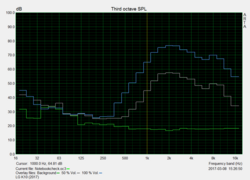
The small speaker on the back has the problem that it can be covered up when the smartphone sits on a table and especially on a soft surface. Even if it can project freely, it does not have a particularly powerful sound: While the maximum volume is still okay at over 84 dB(A), the sound must do completely without bass, and we always have the feeling that the music or voice comes from far away. So the sound is not direct, and during maximum volume, it seems like we hear a slight booming. Even if we cannot expect much in this price range, most of the comparison devices offer a sound that is at least slightly better than the LG K10 (2017).
The sound output via Bluetooth and the 3.5-mm headphone port is good. The included earphones sound reasonable but possibly might not fit all ears.
LG K10 2017 audio analysis
(+) | speakers can play relatively loud (84.34 dB)
Bass 100 - 315 Hz
(-) | nearly no bass - on average 33% lower than median
(+) | bass is linear (2.1% delta to prev. frequency)
Mids 400 - 2000 Hz
(±) | reduced mids - on average 12.7% lower than median
(±) | linearity of mids is average (14.8% delta to prev. frequency)
Highs 2 - 16 kHz
(±) | higher highs - on average 10.4% higher than median
(+) | highs are linear (5.2% delta to prev. frequency)
Overall 100 - 16.000 Hz
(-) | overall sound is not linear (38.8% difference to median)
Compared to same class
» 98% of all tested devices in this class were better, 1% similar, 1% worse
» The best had a delta of 12%, average was 24%, worst was 65%
Compared to all devices tested
» 99% of all tested devices were better, 1% similar, 1% worse
» The best had a delta of 3%, average was 20%, worst was 65%
HTC One A9s audio analysis
(+) | speakers can play relatively loud (82.6 dB)
Bass 100 - 315 Hz
(-) | nearly no bass - on average 18.2% lower than median
(±) | linearity of bass is average (13.5% delta to prev. frequency)
Mids 400 - 2000 Hz
(±) | higher mids - on average 5.4% higher than median
(+) | mids are linear (5.4% delta to prev. frequency)
Highs 2 - 16 kHz
(±) | higher highs - on average 11.7% higher than median
(±) | linearity of highs is average (8.3% delta to prev. frequency)
Overall 100 - 16.000 Hz
(±) | linearity of overall sound is average (27.5% difference to median)
Compared to same class
» 77% of all tested devices in this class were better, 7% similar, 16% worse
» The best had a delta of 12%, average was 24%, worst was 65%
Compared to all devices tested
» 85% of all tested devices were better, 4% similar, 11% worse
» The best had a delta of 3%, average was 20%, worst was 65%
Frequency diagram in comparison (checkboxes can be checked or unchecked!)
When turned off and in standby mode, the LG K10 (2017) does not consume too much power. At other times as well, it is at least in the upper mid-range in terms of energy saving. The HTC One A9s or the Asus ZenFone 3 Max are considerably more power-hungry. At a maximum of 4.15 watts during load, the LG K10 (2017) consumes an average amount of power; at a minimum of 0.76 watts during idle operation, it is even quite small.
The battery runtimes of the LG K10 (2017) are average as well: 8:52 hours in the WLAN test is not a bad result, but the Lenovo Moto G4 Play lasts considerably longer, not to mention the Asus ZenFone 3 Max with its very powerful battery. In practice, with moderate use the LG K10 (2017) can at times last two days or even longer without charging. Charging with the included power supply takes about 2:30 hours. An optional energy-saving mode can be activated manually or when the battery falls below 15%. Even during load, the device lasts almost 5 hours, which is a decent value as well. Overall, the runtimes have increased by 16% compared to the predecessor.
A great plus of the LG K10 (2017): the battery can be removed, so you can carry a spare battery. With the HTC One A9s, for example, this is not possible.
Battery Runtime
| Idle (without WLAN, min brightness) | 24h 37min | |
| NBC WiFi Websurfing Battery Test 1.3 | 8h 52min | |
| Big Buck Bunny H.264 1080p | 10h 13min | |
| Load (maximum brightness) | 4h 58min |
Pros
+ quality casing
+ removable battery
+ decent runtimes
+ high performance
+ NFC and USB-OTG
+ current Android 7
+ sharp camera images
Cons
- weak camera performance in low light
- average microphone quality
- squeaking speaker
- screen could be brighter
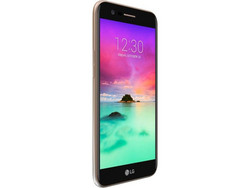
The LG K10 (2017) certainly managed one thing: it has clearly progressed compared to its predecessor. The casing became slimmer and more high quality, the battery lasts noticeably longer- even with more power under the hood. This power increase is so noticeable that many competing devices are also outpaced by the LG K10 (2017). Only the HTC One A9s possesses even more power reserves, however, that device really comes from a different price range.
Of course, there are some complaints. The speaker sounds squeaky, which also makes the hands-free mode hard to use. Likewise, the microphone is of mediocre quality and the screen could be brighter. Actually, that was the extent of our complaints: The operating system is current, the power consumption okay, the camera pictures are quite good and the LG K10 (2017) handles well.
The high performance and the removable battery are the highlights of the LG K10 (2017). The quality of the plastic case also leaves a good impression. In terms of sound, the device could do better, but overall, the LG K10 (2017) is a good budget smartphone.
Overall, a clear recommendation for the LG K10 (2017). Only those who absolutely need more battery capacity will reach for the Asus ZenFone 3 Max but should consider that, in contrast to the LG K10 (2017), the battery cannot be removed there. The same goes for the HTC One A9s, where you again get more performance instead. Nevertheless, the LG K10 (2017) is a very good deal for currently under 200 Euros (~$217).
LG K10 2017 - 2017-04-12 04/12/2017 v6(old)
Florian Wimmer
Connectivity
39 /60 → 66%
Games Performance
16 /63 → 25%
Application Performance
36 /70 → 52%
Smartphone - Weighted Average
Pricecompare
Florian Wimmer, 2017-04-17 (Update: 2019-04- 5)
What Project Screen App Works For My Lg K10 Cell Phone
Source: https://www.notebookcheck.net/LG-K10-2017-Smartphone-Review.213150.0.html
Posted by: mirandalacceir.blogspot.com


0 Response to "What Project Screen App Works For My Lg K10 Cell Phone"
Post a Comment